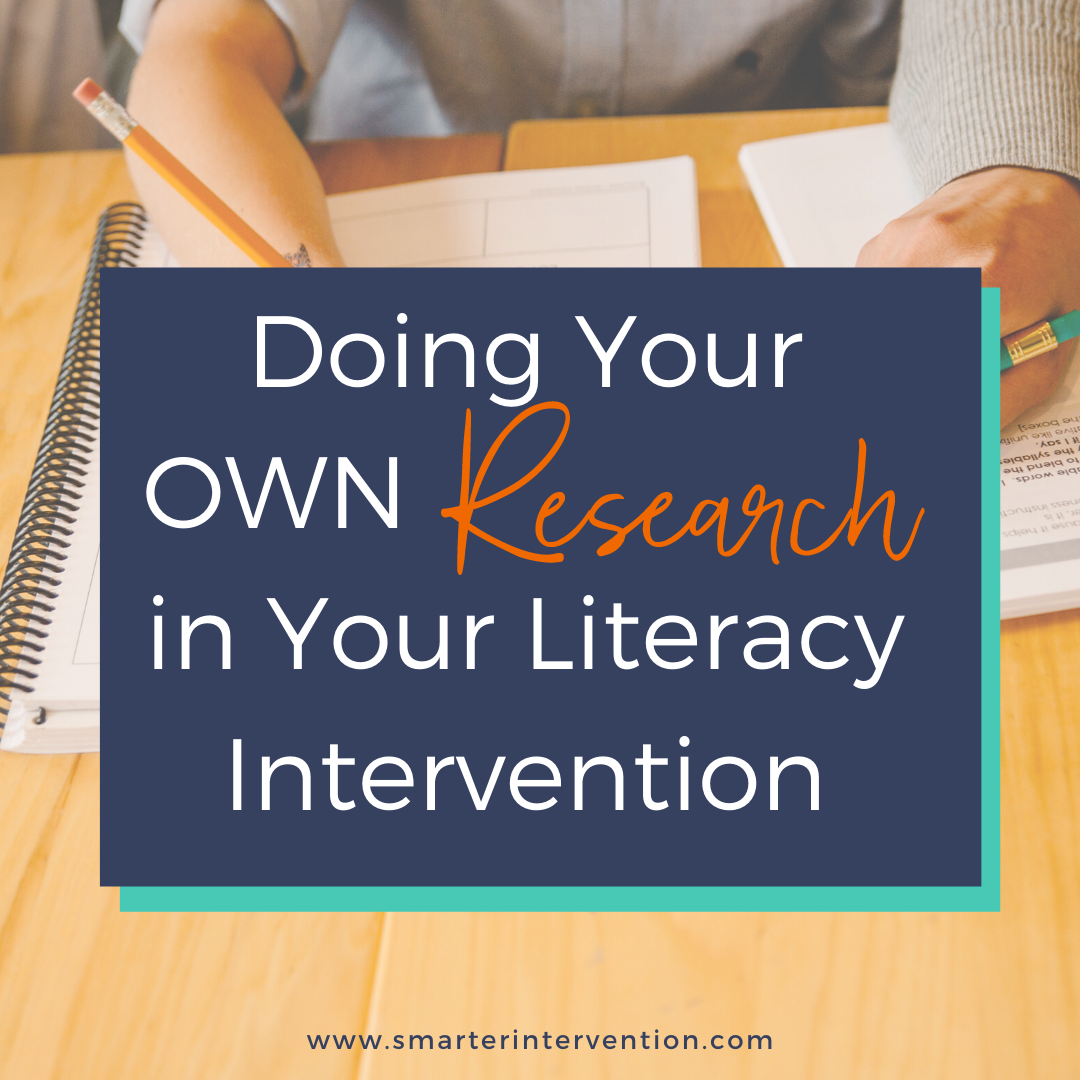Science-based literacy resources and articles
for families, educators and schools
Search by Category:
Categories
- Advocacy
- Authentic Literature
- Business
- Comprehension
- Data Tracking
- Differentiation
- Dyslexia
- Evaluation and Assessment
- Executive Functioning
- Games & Activities
- Helping My Child At Home
- How To
- IEP/504 Plan
- Lesson Planning
- Math
- Online Intervention
- Organization
- Parents
- Phonics
- Phonological Awareness
- Reading Comprehension
- Reading Fluency
- Research
- SLP
- Spelling
- Vocabulary
- Writing
Instead of saying, "The research says..."
How many times have you heard someone (or yourself) say, "but the research says [insert an excerpt from an article here]" to validate an approach or strategy?
We get this, it's entirely well-intentioned and honestly good in many ways BUT there's a better way to validate our approach and strategy in our literacy instruction.
Instead of using "the research says…" we should be using our own experiences, our own students, and our data to be driving us. Keep reading to learn more.
Doing Your OWN Research in Your Intervention
As literacy interventionists, we are told all the time about the importance of “research-based” intervention but no one tells us that this should include our own research! Click through to read more.
The Wrong Ways to Use Data
When we are trying to determine which areas we should focus on with our students we are using our data to provide a guide, a roadmap.
But one of the biggest mistakes we see (we know because we’ve been there) is that we aren’t using data to drive decisions because of two big blocks.
How to Effectively Explain Evidence-Based Literacy Instruction
We find that it is CRITICAL to share a few key pieces of information with our stakeholders. Our stakeholders are all of the people who have a vested interest in our students’ success (parents, other educators, administrators, our coworkers, etc). Click into this blog for more tips, tricks, and information.
Why We Must Track Data Effectively in Literacy Intervention
Today we’re jumping right into one of our favorite things to talk about!
Literacy Intervention Data!!!
We’re fun at parties (well at least back when there used to be parties), trust us…
We know that diagnostic prescriptive instruction following a systematic and structured approach is the most effective way to get students to grade-level and beyond, but how exactly can we provide truly diagnostic and prescriptive instruction?
The Magic in Literacy Intervention
Here’s the deal, structured and systematic literacy intervention will get your students 90% of the way there. The true magic lies in the last 10%.
Reading Intervention Year End Data Analysis
We know we are strange but absolutely LOVE data tracking and data analysis. Not joking. Part of the reason we love data is because Data Tracking & Data Analysis are the absolute best way to see how much growth our reading intervention students have made and to see where they need continued practice.
Your data is your road map, your GPS, for literacy intervention. One of the best things we can do is to get a good look at how our students are performing overall. This data will be invaluable to parents, other professionals, and next year’s teacher.
Data Tracking with Word Lists
We try to progress monitor consistently to make sure students are on track with the concepts we are teaching. It is important that we are consistently spiraling back to previously instructed concepts to make sure they are getting it. Therefore, because we are already doing this it makes sense for us to create goals around mastery of words we have explicitly taught.
The 3 Most Common Mistakes in Data Tracking
So data tracking is one of those necessary evils for all interventionists, special educators, speech language pathologists, teachers…we all can commiserate together.
But it’s one of those things that is just absolutely critical to determine whether or not students are growing and making progress in their intervention setting. We see students who are struggling to read and have gaps and we need to make sure those gaps are in fact closing.
So on top of all the other things we are managing in our reading intervention setting, from behavior management, to lesson introduction and skill targeting, we need to be tracking and monitoring data during our sessions.
Here are the three biggest mistakes we often see when supporting special education teams and interventionists…and no judgement here because we’ve #beenthere. Click through to read more and grab our data tracking sheets.
Ability Grouping Made Easy
With conferences upon us and a new reporting period staring us down, it is the perfect time to evaluate where are students stand after their first reporting period, and to possibly re-adjust our grouping.
Using data you gathered during this first quarter (DRA, iReady, STAR testing, or another common assessment) you can plot your students on our this diamond in order to get a clear picture about how to proceed with ability based grouping for the upcoming quarter.
#1 Tip to Making Huge Student Growth in Literacy
One of the best ways we can skyrocket student success in literacy is by setting the intention to do so. So obviously, if we want students to improve their literacy ability we need to recognize that they need to improve their literacy ability...











